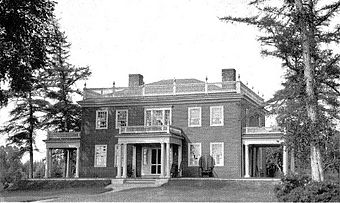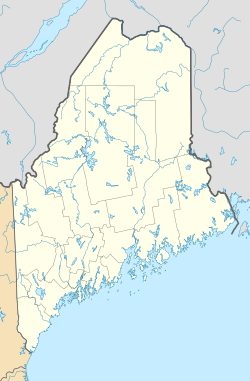Parker House (Blue Hill, Maine) facts for kids
Quick facts for kids |
|
|
Parker House
|
|

Photograph c. 1900
|
|
| Location | 185 South St., Blue Hill, Maine |
|---|---|
| Area | 5.8 acres (2.3 ha) |
| Built | 1816 |
| Architect | Clough, George A. |
| Architectural style | Federal |
| NRHP reference No. | 04001047 |
| Added to NRHP | September 22, 2004 |
The Parker House is a historic home located at 185 South Street in Blue Hill, Maine. It was built around 1816. Later, in 1900, it was updated in the Colonial Revival style by architect George Albert Clough. Because of its important architecture, the house was added to the National Register of Historic Places in 2004.
Contents
Discovering Parker House History
The Parker House was built for Robert Parker and his wife Ruth. Ruth was the daughter of Joseph Wood, who helped found Blue Hill. The house was likely built in 1816, on land that belonged to the Parker family.
Over the years, the house had different owners. In 1900, a woman named Mrs. Frederick Augustus Merrill bought it. She was a descendant of Ruth Parker's sister. Mrs. Merrill hired architect George A. Clough to remodel the house.
Architectural Style and Changes
The Parker House is special because of its original design and the changes made by George A. Clough. Clough added features in the Colonial Revival style. This style brought back classic looks from early American homes.
The house still has much of its original woodwork. It also features beautiful fireplaces. Clough added porches with Tuscan columns. He also added a wrap-around porch and railings on the roofs, though the porch has since been removed.
A later owner made changes inside the house. They combined two rooms downstairs. They added columns and pilasters to mark where the rooms joined. This was a design idea used by another famous architect, John Calvin Stevens.
Family History and Home Decor
The Merrills wanted their home to feel like it had a long family history. They filled the Parker House with oil paintings of their family. They also brought in old furniture and items that had been in their family for generations.
For example, they had a table that came from Beverly with Joseph Wood, an early settler. This table was later given to the Blue Hill Historical Society. They also had an old spinning wheel, which was a family heirloom.
Stories and Legends of the House
There are many stories about the Parker House. One popular tale says the house was finished before 1813. This story claims that workers on the roof heard guns firing from Castine. This was the start of the War of 1812. The story says the workers dropped their tools and rushed to join the fight.
While this story is exciting, it is likely not true. It was probably made up to add a romantic touch to the early American spirit. Such tales were common at the time.
A Summer Home in the Country
The Parker House was designed to be a summer home. Clough's French windows were perfect for warm weather. Mrs. Merrill also wanted the house to feel like a country retreat.
She kept a Jersey cow and chickens, which was a popular trend. She also grew gladiolus flowers in her garden. She even entered them in the annual Blue Hill Fair.
Mrs. Merrill was interested in improving farming. She hired Frederick Vernon Coville. He was famous for developing the modern Highbush Blueberry. He planted some of his special blueberry plants on the property.
Artistic Pursuits and Family Talents
Mrs. Merrill also enjoyed art. The house has two of her oil paintings. It also has a set of hand-painted Limoges china. You can also see examples of her needlepoint work.
Her husband, Dr. Merrill, was also artistic. He made several picture frames in the house. One frame was made from wood from the "Boston Old Elm." This tree was known as "Boston's Oldest Inhabitant."
Their younger daughter, Ruth, also became an artist. She studied at the School of the Museum of Fine Arts, Boston. Her self-portrait, which was her final project, still hangs in the house today.
Parker House Today
The Parker House is now over 200 years old. It has been carefully restored. It was recently part of a charity house tour. The house shows its close ties to a larger nearby home called Barncastle.
Visitors to the tour could see old scrapbooks, portraits, and photos. These items belonged to Effie Hinckley Ober Kline, who built Barncastle. She was the founder of the Boston Ideal Opera Company. She was also a supporter of the arts.
Images for kids




